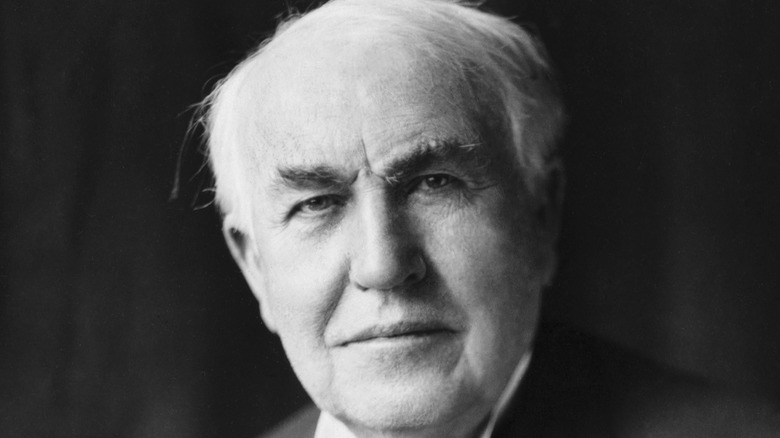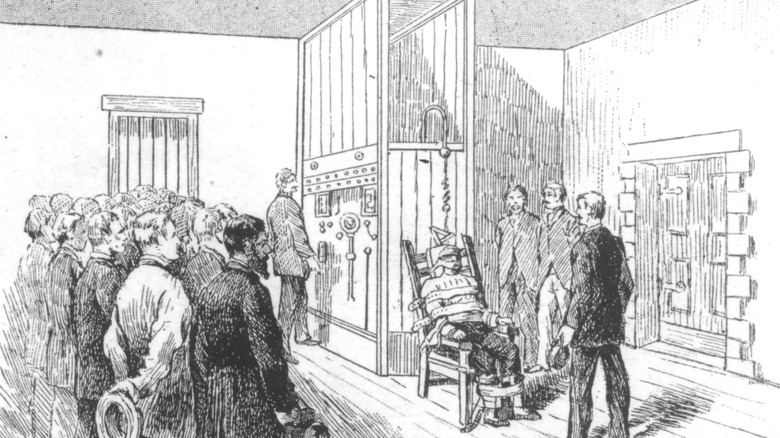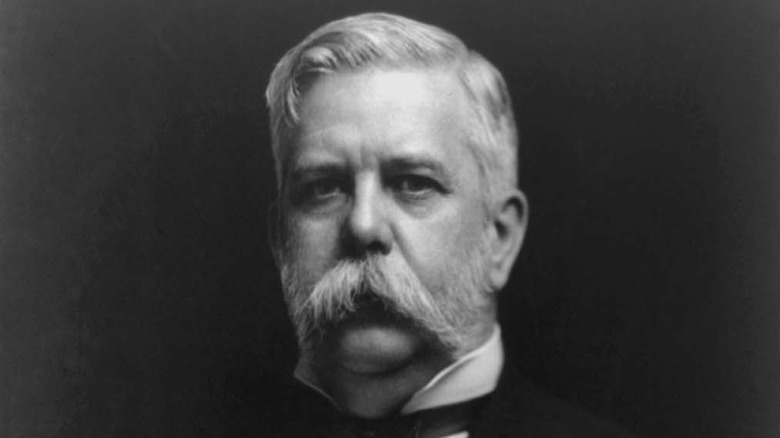The Execution Device Thomas Edison Secretly Helped Finance
In the late 1800s, three great inventors — Nikola Tesla, Thomas Edison, and George Westinghouse — feuded over which type of electrical system was best to be used as the standard for electricity. While Edison supported direct current (DC), both Westinghouse and Tesla championed the alternating electric current (AC). Edison was adamant to show people that using AC was dangerous, so he staged public events where various animals were electrocuted and killed with the use of alternating current. According to Smithsonian Magazine, the feud – dubbed the "War of the Currents" — made headlines in newspapers and even reached the Supreme Court.
At the same time the two inventors were battling, Alfred Southwick, a New York-based dentist, worked on developing a better way of execution than hanging. He was inspired by using electricity after witnessing a drunk man accidentally get killed after touching a generator and getting electrocuted. This gave him the idea of inventing an electric chair, and he asked for Thomas Edison's guidance to create the apparatus (via Business Insider). However, the famous inventor publicly denounced capital punishment, so he suggested that Southwick propose his plan to Westinghouse instead. That wasn't his only reason, though, as Edison also thought that if his rival agreed to help create the electric chair, the AC system would be used and would prove how dangerous it was compared to DC. In response to Southwick, Edison said that alternating current was the best to use for instant death that will bring the "least amount of suffering," as reported by Time.
The funding of the electric chair
Thomas Edison's plan didn't work out, though much like him, George Westinghouse didn't want his AC generators to be associated with executions. He refused to sell his generators to New York officials, and as a result, electricity salesman Harold Brown was tasked to build the electric chair. Per Business Insider, Edison financially backed the project in secret just to make sure that Brown built the execution device using an AC system. Brown somehow got his hands on AC generators to use for the contraption. The electric chair was eventually completed and was to be used on a convicted murderer, William Kemmler, who was sentenced to death. Edison used the electric chair as a means to prove AC was far more dangerous than DC; he even coined the term "Westinghoused" to describe criminals that would be executed using the new electrical contraption, as reported by the Smithsonian Magazine.
The propaganda Thomas Edison was spreading angered Westinghouse, and he was facing the loss of millions of dollars if the public believed that his AC generators were too dangerous to be used in homes. Westinghouse donated $100,000 toward Kemmler's legal fees, and the inmate filed an appeal with the Supreme Court stating that being executed on the electric chair was an inhumane and cruel punishment. The Supreme Court disagreed with Kemmler and stated, "Punishments are cruel when they involve torture or a lingering death" (via Death Penalty Information Center). The appeal was denied and Kemmler's execution pushed forward.
George Westinghouse wins War of the Currents
Alfred Southwick was present to witness William Kemmler die on the electric chair on August 6, 1890. Before the execution, per Death Penalty Information Center, Kemmler said to the officers, "Don't let them experiment on me more than they ought to." He was strapped securely on the chair that was powered by an AC dynamo, and was pronounced dead after being electrocuted for 17 seconds with about 700 volts of electricity. However, a witness noticed that Kemmler was still alive. There were shouts to turn the current back on, but the generator needed some time to recharge. Witnesses saw Kemmler gasping and wheezing while waiting for the second round of electricity to course through his body. Kemmler was shocked a second time and he was, again, pronounced dead after a few minutes (via Smithsonian Magazine).
George Westinghouse heard reports of Kemmler's execution and was shocked by what happened. "They could have done better with an ax," he said. In 1893, the inventor was given the contract to provide electricity at the Chicago World's Fair, which gave him a chance to showcase the AC system in a positive light. A few years later, he acquired another important contract — using AC generators in a Niagara Falls power plant. Westinghouse's success ended the War of the Currents, with him emerging as the victor, as reported by History. Edison, on the other hand, later admitted that AC is the better technology than DC and said that he knew that all along.


